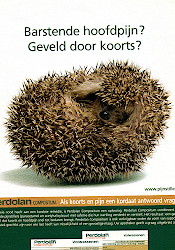In our next
examples (5, 6) the approach is different.
We recognize the
Mother Nature tune which is played very often.
We are back with the
spines but the important thing is now the
entire collection of spines.
Hedgehogs carry many, between 5 000 and 7 000 (
†), spines and together these form a unique self-defense system
when the animal curls up —
though this behaviour is not very helpful in the situations shown in №s 2 – 4.
Sometimes it's mother
nature that takes care of protection against external threats
(5).
That is how it works for Hedgehogs, but
when it comes to defending peace and freedom, …
then you better trust
the state-of-the-art equipment of № 5. If your country is threatened then their defence systems will help you put up
your spines, just like the Hedgehog's.
Just like the
Hedgehog
man also has his own natural defence system
says № 6.
The title is followed by a long text with words like immune system, natural resistance, well-being, science, Lactobacillus, and so on.
We can summarize it as : sometimes man's system comes under stress and then Chambourcy's
new generation of fresh dairy products
comes to the rescue.









